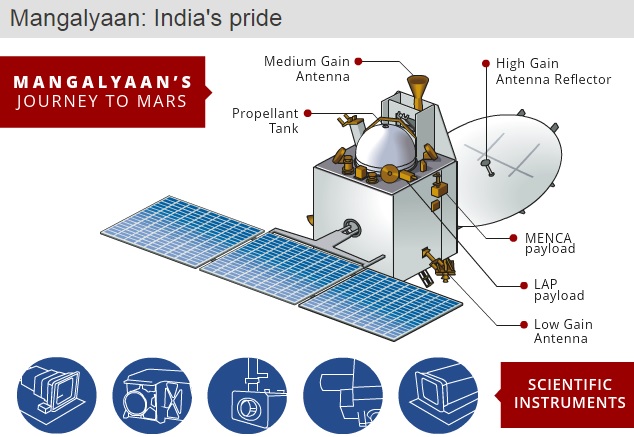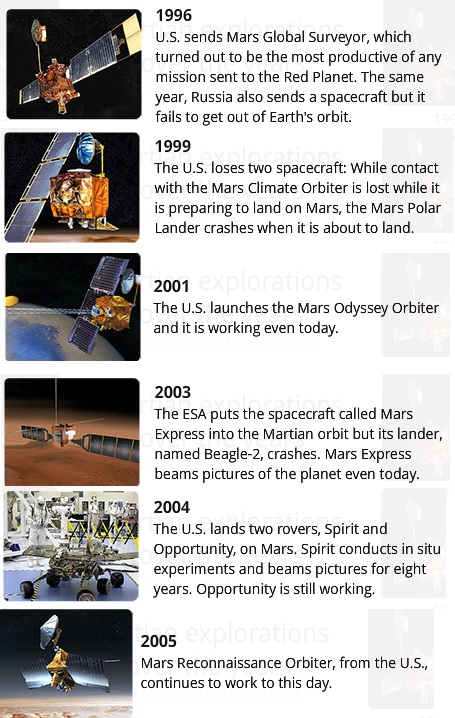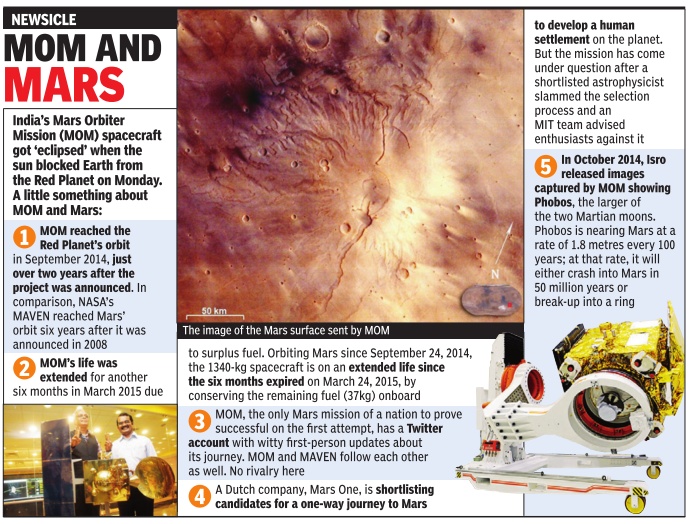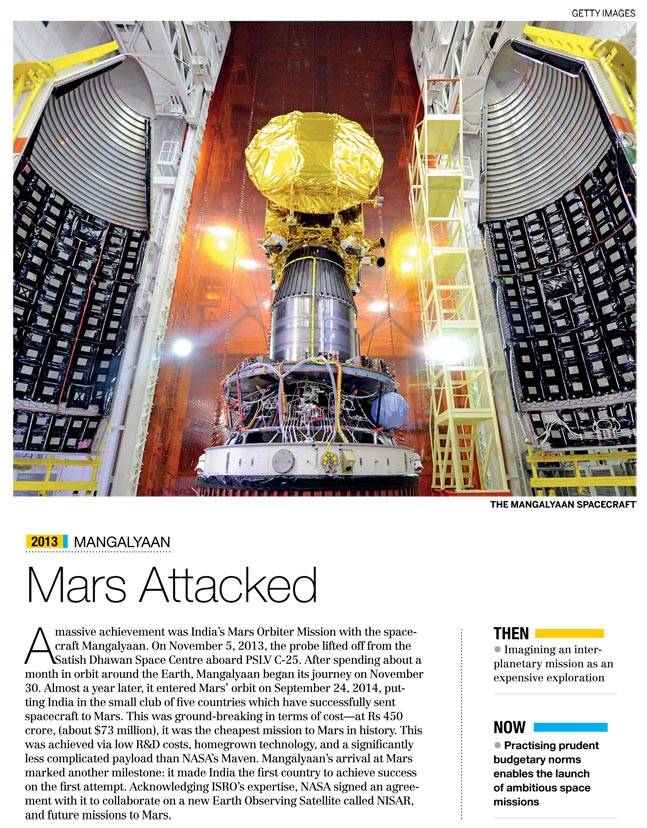Mars Orbiter Mission




This is a collection of articles archived for the excellence of their content.
|
Contents |
Timeline
Mars Orbiter Mission: Timeline
Here's the timeline of Mars Orbiter Mission.
05-11-2013: PSLV-C25, in its twenty fifth flight, successfully launches Mars Orbiter Mission Spacecraft from SDSC SHAR Sriharikota
07-11-2013: The first orbit raising manoeuvre of Mars Orbiter Spacecraft, starting at 01:17 hrs(IST) on Nov 07, 2013 successfully completed
08-11-2013: The second orbit raising manoeuvre of Mars Orbiter Spacecraft, starting at 02:18:51 hrs(IST), with a burn time of 570.6 seconds successfully completed. The observed change in Apogee is from 28814 km to 40186 km
09-11-2013: The third orbit raising manoeuvre of Mars Orbiter Spacecraft, starting at 02:10:43 hrs(IST) on Nov 09, 2013, with a burn time of 707 seconds successfully completed. The observed change in Apogee is from 40186km to 71636km.
11-11-2013: In the fourth orbit-raising operation conducted on Nov 11, 2013 the apogee (farthest point to Earth) of Mars Orbiter Spacecraft was raised from 71,623 km to 78,276 km by imparting an incremental velocity of 35 metres/second (as against 130 metres/second originally planned to raise apogee to about 100,000 [1 lakh] km). The spacecraft is in normal health.
12-11-2013: Fourth supplementary orbit raising manoeuvre of Mars Orbiter Spacecraft, starting at 05:03:50 hrs(IST) on Nov 12, 2013, with a burn Time of 303.8 seconds successfully completed. The observed change in Apogee is from 78276km to 118642km.
16-11-2013: The fifth orbit raising manoeuvre of Mars Orbiter Spacecraft, starting at 01:27 hrs(IST) on Nov 16, 2013, with a burn Time of 243.5 seconds successfully completed. The observed change in Apogee is from 118642km to 192874km.
01-12-2013: Medium Gain Antenna of the Mars Orbiter Spacecraft is powered for long distance communication, subsequent to successful Trans Mars Injection (TMI) manoeuvre. Trans Mars Injection (TMI) operations completed successfully. The liquid engine burn time was 1328.89 sec and the imparted incremental velocity was 647.96 m/sec.
02-12-2013: Spacecraft has travelled a distance of 5,36,000 km by 17:00 hrs (IST) of Dec 2, 2013. It has crossed the distance to Moon's orbit around Earth (mean distance 3,85,000 km) this morning.
04-12-2013: Spacecraft has traversed beyond the Sphere of Influence (SOI) of Earth extending about 9,25,000 km at around 1:14 hrs (IST) on Dec 4, 2013.
11-12-2013: The first Trajectory Correction Manoeuvre (TCM) of Spacecraft was carried out successfully at 06:30 hrs (IST) by firing the 22 Newton Thrusters for a duration of 40.5 seconds. The spacecraft is travelling at a distance of about 29 lakh (2.9 million) km away from Earth.11-02-2014: 100 Days Of Mars Orbiter Spacecraft.
09-04-2014: Mars Orbiter Spacecraft Crosses Half Way Mark of its Journey.
12-06-2014: The second Trajectory Correction Manoeuvre (TCM-2) of India's Mars Orbiter Spacecraft was successfully performed on June 11, 2014 at 1630 hrs IST. TCM-2 was performed by firing the spacecraft's 22 Newton thrusters for a duration of 16 seconds.
16-09-2014: Time-tagged commands to execute Mars Orbit Insertion (MOI) uploaded.
17-09-2014: Uploading of commands for Fourth Trajectory Correction Manoeuver and test-firing of Main Liquid Engine (scheduled for Sep 22, 2014) is in progress.
22-09-2014: Test Firing of Main Liquid Engine of Mars Orbiter Spacecraft is successful.
24-09-2014: Mangalyaan enters Mars orbit.
Important factoids
India created history on September 24, becoming the first country to successfully get a spacecraft into the Martian orbit on its maiden attempt. Here are 10 things you should know about the Mars Orbiter Mission or Mangalyaan. 1. Before India, various countries have launched Mars missions, but out of the 51 attempts, only 21 were successful. India now joins the Martian club that comprises the US, Russia and the European Space Agency.
2. US space agency Nasa was one of the first to congratulate Isro on its success. Prime Minister Narendra Modi gave a congratulatory speech highlighting the success and hardwork of the Isro scientists.
3. After the Mars mission, the Indian space agency will work together with Chinese space scientists to prepare a roadmap for a series of missions to be implemented together. Isro chief's K Radhakrishnan's tenure will come to an end by the time of 2014. The first three months of 2015 might see Radhakrishnan practice Kathakali.
4. A methane sensor will look for sources of the gas. While the Mars colour camera clicks away, a thermal infrared spectrometer will study heat emission, minerals and soil on Mars.
5. India's MOM is the cheapest inter-planetary mission. It cost about a tenth of Nasa's Mars mission Maven that entered the Martian orbit on September 22. PM Narendra Modi applauding Indian scientists had said,"Hollywood movie Gravity costs more than our space mission."
6. The spacecraft structure and propulsion hardware configurations are similar to Chandrayaan 1, which was country’s first successful robotic lunar probe. Specific improvements and upgrades were made for a Mars specific mission.
7. The most important experiment is to check for the presence of methane that can indicate just what kind of life existed on Mars, if at all.
8. The orbiter, after a 300-day flight, has covered a distance of 680 million kilometres to reach the Red Planet's orbit.
9. As it goes around Mars on an elliptical orbit with the closest point around 420km and the farthest around 80,000km, MOM will employ five equipment that collectively weight 15kg to do scientific studies.
10. The spacecraft trajectory would be tracked from Nasa's Jet Propulsion Laboratory facilities at Goldstone (US), Madrid (Spain) and Canberra (Australia).
2020: clicks photograph of Mars’ biggest moon

From: Surendra Singh, 7 yrs on, Mars orbiter still active, clicks photo of its biggest moon, July 5, 2020: The Times of India
Isro To Study Data To Decide On Next MOM Payload: Chief
The Mars colour camera on board the Mars Orbiter Mission (MOM) of Indian Space Research Organisation (Isro) has captured the image of Phobos, the closest and biggest moon of the red planet. The space agency on Friday night released the image that was taken on July 1 when the orbiter was about 7,200 km from Mars and 4,200 km from Phobos.
The photograph is a composite image generated from six camera frames and has been colour-corrected.
The surprising thing is that MOM is still active years after its launch on November 5, 2013. Talking to TOI, Isro chairman K Sivan said, “MOM was scheduled to last only for six months as per Isro’s plan but it is still functioning nearly seven years after its launch. Though some systems are not working, the orbiter is continuously beaming images of the Red planet. It’s a great achievement.”
For the upcoming MOM-2 mission, he said, “We will study images and data from the active MOM. We will then discuss what we have explored and what we want to explore in the next mission. Accordingly, the kind of payload will be discussed and decided.”
‘Extra fuel in orbiter extended its lifespan’
Isro had successfully placed the Rs 450-crore MOM in the Red planet’s orbit on September 24, 2014, making India the first Asian country to reach the Martian orbit and the first nation in the world to do so on its maiden attempt.
Explaining the reason for its stretched lifespan, Sivan told TOI, “Agency had put extra fuel in the orbiter for any contingency plan. In fact, it had also factored in the extra fuel needed for orbit correction if the rocket had put the spacecraft in a slightly different orbit. The extra fuel kept for all these contingency plans has actually extended the lifespan of MOM. But we don’t know how much fuel is left and how long the orbiter will function.”
Phobos is largely believed to be made up of carbonaceous chondrites. The violent phase that Phobos has encountered is seen in the large section gouged out from a past collision (Stickney crater) and bouncing ejecta (material thrown out due to volcanic eruption or meteoritic impact). Stickney, the largest crater on Phobos along with other craters (Shklovsky, Roche & Grildrig) are also seen in this image, an Isro statement said.
MOM, also popular as Mangalyaan, is studying the Martian surface and mineral composition as well as scanning its atmosphere for methane (an indicator of life on planet Mars).
Amount spent on Mars Orbiter Mission
Chethan Kumar, Isro spend on MOM wasn't even Rs 450cr, Nov 18 2016 : The Times of India
The Indian Space Research Organization (Isro), which, according to all official claims, is reported to have spent Rs 450 crore on the Mars Orbiter Mission (MOM), did not even spend the whole of that shoestring budget.
An austere Isro managed to save Rs 2.61 crore which it promptly returned to the Centre, reaffirming MOM to be the world's cheapest mission to the red planet, at a cost of Rs 447.39 crore.
Documents revealing the audited expenditure of all Isro projects in the last five years reveal that MOM isn't the only such project.
Though Isro sought Rs 892.69 crore to launch the GSAT-15 communication satellite, the Centre released on ly Rs 830.88 crore. But Isro, which launched GSAT-15 last November, completed the project using just Rs 806.4 crore, saving Rs 24.48 crore. Similarly, it had sought Rs 897.94 crore for GSAT-16 but got only Rs 865 crore and the space agency went on to complete the project with Rs 864.12 crore.
“Unlike the Mars mission, which was a one-time project when cleared, the GSAT programme envisages launching several more satellites. Therefore, the money saved from its launch is with Isro to be used for future satellites,“ a senior official said.
How costs were minimised
Jonathan Amos, 24 September 2014: BBC
India's space programme has succeeded at the first attempt where others have failed - by sending an operational mission to Mars.
The Mangalyaan satellite was confirmed to be in orbit shortly after 0800, Indian time. It is, without doubt, a considerable achievement.
This is a mission that has been budgeted at 4.5bn rupees ($74m), which, by Western standards, is staggeringly cheap. The American Maven orbiter that arrived at the Red Planet is costing almost 10 times as much.
Back in June, Indian Prime Minister Narendra Modi even quipped that India's real-life Martian adventure was costing less than the make-believe Hollywood film Gravity.
Even Bollywood sci-fi movies like Ra.One cost a good chunk of what it has taken to get Mangalyaan to Mars.
So how has India done it? For sure, people costs are less in this populous nation, and the scientists and engineers working on any space mission are always the largest part of the ticket price.
Home-grown components and technologies have also been prioritised over expensive foreign imports.
But, in addition, India has been careful to do things simply.
"They've kept it small. The payload weighs only about 15kg. Compare that with the complexity in the payload in Maven and that will explain a lot about the cost," says Britain's Prof Andrew Coates, who will be a principal investigator on Europe's Mars rover in 2018.
"Of course, that reduced complexity suggests it won't be as scientifically capable, but India has been smart in targeting some really important areas that will complement what others are doing.”
Mangalyaan has gone equipped with an instrument that will try to measure methane in the atmosphere.
This is one of the hottest topics in Mars research right now, following previous, tantalising observations of the gas. Earth's atmosphere contains billions of tonnes of methane, the vast majority of it coming from microbes, such as the organisms found in the digestive tracts of animals.
The speculation has been that some methane-producing bugs, or methanogens, could perhaps exist on Mars if they lived underground, away from the planet's harsh surface conditions.
It is a fascinating prospect. So, even though Mangalyaan has a small payload, it will actually address some of the biggest questions at the Red Planet. Western scientists are excited also to have the Indian probe on station.
Its measurements of other atmospheric components will dovetail very nicely with Maven and the observations being made by Europe's Mars Express. "It means we'll be getting three-point measurements, which is tremendous," says Prof Coates.
This will enable researchers to better understand how the planet lost the bulk of its atmosphere billions of years ago, and determine what sort of climate it could once have had, and whether or not it was conducive to life.
I have read a lot about the criticism of Mangalyaan and India's space programme.
There's an assumption among many, I guess, that space activity is somehow a plaything best left to wealthy industrial countries; that it can have no value to developing nations.
The money would be better spent on healthcare and improved sanitation, so the argument goes.
But what this position often overlooks is that investment in science and technology builds capability and capacity, and develops the sort of people who benefit the economy and society more widely.
Space activity is also a wealth generator. Some of the stuff we do up there pays for stuff down here.
The industrialised nations know it; that's one of the reasons they invest so heavily in space activity.
Consider just the UK. It has dramatically increased its spending on space in recent years.
The government has even identified satellites as being one of the "eight great technologies" that can help rebalance the UK economy and drive it forward.
India wants a part of this action, too, and in Mangalyaan and its other satellite and rocket programmes, the nation is putting itself into a strong position in international markets for space products and services.
The team
Sushant Talwar,August 14, 2019: The Times of India
On September 24, 2014, India created history when it achieved success with its first-ever Mars mission, Mangalyaan. The mission was launched by ISRO on November 5, 2013, onboard PSLV-C25 rocket which took the Mars Orbiter into space on its twenty-fifth flight.
The mission was launched from the first launch pad at Satish Dhawan Space Centre SHAR, Sriharikota and has since remained in the planet's orbit, outliving its initial mission life of 6 months.
Mangalyaan's flight of great significance to the nation as it not only became India's first interplanetary mission but also made it the first Asian nation to reach Mars' orbit and more importantly, the first nation in the world to do so on its first attempt.
Timeline of the Mangalyaan mission
In terms of how the mission unfolded, it was all by the book and thankfully uneventful.
On November 5, 2013, ISRO's PSLV C25 took the Mars Orbiter Mission from Sriharikota, Andhra Pradesh.
November 7, 2013, the first Earth-bound manoeuvre of the mission was performed.
November 8, 2013, second Earth-bound manoeuvre of the mission was completed.
November 9, 2013, third Earth-bound manoeuvre performed.
November 11, 2013, the fourth Earth-bound manoeuvre completed.
November 12, 2013, fifth Earth-bound manoeuvre performed.
November 16, 2013, the mission completed its sixth Earth-bound manoeuvre.
On December 1, 2013, Mangalyaan leaves Earth's orbit and performs Trans-Mars injection.
December 4, 2013, ISRO informs that the mission leaves Earth's Sphere of Influence of 9.25 lakh km radius.
December 11, 2013, ISRO completes first-course correction manoeuvre performed on the spacecraft.
June 11, 2014, 2013, another course correction manoeuvre is executed by ISRO.
On September 22, 2014, Mangalyaan enters Mars' Gravitational Sphere of Influence.
September 24, 2014, Mangalyaan reaches the intended orbit around Mars, making India the first country in the world to have successfully launched its mission to the Red Planet on the very first attempt.
The team involved in India's Mangalyaan Mars mission
While much has been talked about the team of women who helped make the Mangalyaan mission a reality, it is also worth taking a look at others who made the Mars mission possible.
K Radhakrishnan lead the mission and oversaw the activities of ISRO as well as the mission.
S Ramakrishnan was a Director who helped in Development of the PSLV and liquid propulsion system.
P. Kunhikrishnan was a Project Director in the PSLV programme. He was also a Mission director of PSLV-C25/Mars Orbiter Mission.
Moumita Dutta was the Project manager of the Mangalyaan mission.
Nandini Harinath was the Deputy Operations Director of Navigation.
Ritu Karidhal was the Deputy Operations Director of Navigation.
BS Kiran was the Associate Project Director of Flight dynamics.
V Kesava Raju was the Mission Director at the Mars Orbiter Mission.
V Koteswara Rao was ISRO scientific secretary.
Chandradathan was the Director of the Liquid Propulsion system.
AS Kiran Kumar was the Director of the Satellite Application Centre.
M Annadurai was the Programme Director and in charge of budget management as well as direction for spacecraft configuration, schedule and resources.
MYS Prasad: Director at Satish Dhawan Space Centre. He was also the Chairman at Launch Authorisation Board.
SK Shivakumar was a Director at ISRO Satellite Centre. He was also a Project Director for Deep Space Network antenna.
S Arunan was a Project Director at Mars Orbiter Mission and he led the team to build the spacecraft.
B Jayakumar was an Associate Project Director at the PSLV programme who was responsible for testing the rocket systems.
MS Pannirselvam was the Chief General Manager at the Sriharikota Rocket port and was the man tasked to maintain launch schedules.
Mangalyaan 2 cost
While a remarkable scientific achievement in itself, the biggest reason that Mangalyaan was such a big deal was because of how little money it cost to make it. As opposed to Mars and deep space missions from other space agencies such as NASA and Roscosmos, ISRO's Mangalyaan was built at a fraction of the cost.
Budgeted at around $75 million, Mangalyaan mission cost just 11 per cent of NASA's MAVEN orbiter, which cost somewhere in the region of $485 million to develop — and around $187 million for the launch into space and further ground support. The mission was so cost-effective that it even forced Prime Minister Narendra Modi to quip that India's real-life Mars mission costs less than the Hollywood film Gravity.
The real women of MOM
Chelsea Gohd , August 23, 2019: Space.com
While the women of "Mission Mangal" may have been fictional, they represented the real women behind India's first mission to Mars. The mission that, in just 18 months and with a budget of only $74 million (less than the budget of the film "The Martian"), placed a satellite in orbit around Mars. The team worked anywhere from 10 to 14 hours a day to complete the seemingly impossible mission.
Ritu Karidhal, an aerospace engineer and senior scientist at ISRO who served as the deputy operations director for MOM, has worked at the space agency for over 20 years. Karidhal went on to become the mission director of ISRO’s Chandrayaan-2 mission.
Nandini Harinath, a rocket scientist at ISRO, has worked on 14 missions over a span of 20 years at the agency. Harinath took an early interest in science after being exposed to "Star Trek" as a child.
Anuradha T.K., the senior-most woman in an officer position at ISRO, is a scientist who specializes in sending communications satellites to space. She has worked at the agency for almost 40 years, and is considered by many at ISRO to be a role model as a successful woman in science, according to the BBC.
Minal Rohit, a systems engineer at ISRO, was another instrumental scientist in ISRO's MOM. Moumita Dutta, another critical member of the MOM team, is a physicist who works at the Space Applications Centre (SAC) at ISRO. Dutta worked as project manager for the Methane Sensor for Mars (MSM) and developed, optimized and calibrated an optical system for the satellite.
Mission Mangal reviewed by a Mangalyaan team member
I work in ISRO and watched the movie on the first day , out of sheer curiosity. The trailer sucked, and my colleagues were fuming over it. I wished the movie wouldn't be that bad, and thought of giving it a try.
- Spoiler alert*
PROS:
As a Mangalyaan mission team member , I felt proud of ourselves watching the movie. The movie boosts up the morale of the employees of ISRO and also gives the younger generation something to look up to.
It shows the difficulties faced by women in this organisation wherein many of them are struggling everyday to bring about work life balance.
Finally there is someone to speak for us, to tell the world that we do not have the typical government culture with 9to5 working hours. We toil hard, stay till late night, work on weekends and holidays for every other Mission, if the schedule calls for it.
The animation and the sound effects of the rocket launch and satellite scenes were fantastic. CONS There were a LOT of technical mistakes in the movie. Let me list them out, as far I could remember.
Firstly, the mangalyaan carrying rocket which they called as “PSLV" , isn't the structure of PSLV. PSLV is 4STO vehicle, with only solid and liquid stages. But whatever rocket they showed, seemed to have a cryo stage and with 3STO configuration. I felt it was a blatant error.
Before every launch there are so many planned activities and tests that have to be executed prior to going on automatic launch sequence mode. You can't just abort the launch, pack off home and then come back and launch the vehicle by just turning on a few switches. Even launch abort is a huge procedure in itself, taking hours to undo things including venting out all the propellants. And how did Vidya balan manage to fly back and forth between Bangalore and Shriharikota in the same day?
During one of the orbit raising maneuvers, the LAM engine failed to fire. But nobody analysed what went wrong? How could one be sure that it'd fire the next time? ISRO never ever proceeds without thoroughly analysing reasons for failure. Never. I felt that was a loose end.
Mars has got prograde orbit just as Earth. Mangalyaan was launched in a prograde orbit with Mars. But what they showed in the animation seemed like retrograde orbit. (In the scenes before and after occultation).
I think I saw animation of solar panel and antenna deployment after the satellite gets into transplanetary orbit. This is completely absurd(if so). solar panels deploy soon after satellite is injected into space.
That's all I could remember now, which means there are more technical mistakes. On the non technical side, Kritika goes absent from office for nearly a month without any notice?? And she just joins back and her reporting officer Tara welcomes with hip-shaking dance. Wow! Wish my boss ever did that!!
I felt that if only the film crew had done some more home work and got their basics right, it would have been far better outcome. The subject they took in hand had lot of scope in it and all the director had to do was to spoil it with the usual Bollywood style narrative.
On a lighter note, we scientists do not clean, mop and paint our offices. We have staff for that. We already have got enough on our plates.
